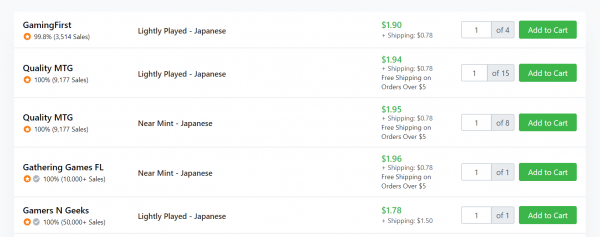Are you a Quiet Speculation member?
If not, now is a perfect time to join up! Our powerful tools, breaking-news analysis, and exclusive Discord channel will make sure you stay up to date and ahead of the curve.
I would like to start this article off by dispelling a commonly repeated myth. “EDH players don’t buy foreign cards”. While often EDH players want to be able to read their cards, they also want cheap cards. As long as your card is in a desirable rare language or cheap enough, it will sell given enough time. Often when people complain about not being able to make money off foreign cards, they are trying to treat them the same as English cards in how they buy and price them.
Most people make this mistake early in their MTG finance career and then they completely write off foreign cards as a fool's errand, refusing to ever buy them. If you understand the risks and shift your expectations, foreign cards can be just as lucrative as their English counterparts.
Pricing Non-Foils
When you are pricing foreign cards you need to consider a lot more factors than when you are pricing English cards. The most glaring factor is what language the cards are; most people generally associate Japanese, Korean and Russian to be the most desirable languages because of their appearance and rarity. Generally speaking, this is a good rule of thumb when considering if you want to price a card above its English counterparts.
The next factor that I look at is other listings. When I am looking to price a card above an English version, I only look at listings for that language as the premium price assumes that the buyer wants that specific version. When there are many other vendors for that language, I try to be very competitive with my pricing even when I price cards at a premium. I do this because vendors on this platform primarily compete for sales by price. Another important thing to analyze when looking at other vendors is the quantity they have in stock. Buyers generally gravitate to vendors that have the full quantity they want rather than ordering from several vendors to save a little bit.
While I am looking at other vendor’s pricing, I also look at the last sold listing that can be viewed from the TCGPlayer seller portal. This can add some important context to how you should price your card if no vendors have any copies in stock. This factor does need to be considered carefully as it does not give a date to when the sale happened, so if a card has been reprinted recently, it may not be a very good indicator of price.
A factor that is deceptively important is the edition of a card. Some sets have a lot more desirability because of their appearance and their rarity in a foreign language. For example, it's much harder to find foreign cards from older sets like Future Sight and Mirrodin when compared to more modern sets like Fate Reforged or Dominaria. Another factor to consider when looking at the set of a card is if the set is the original printing of a card. These can be more desirable to a buyer as they may want their whole deck in original printings.
One more important element to pricing foreign cards is what format the card is played in. Often Legacy and Modern cards will be much more desirable as they are non-rotating formats where players are more incentivized to play a deck for longer and pimp it out. Often the last factor I consider for a foreign card is its condition. As long as your card is at least Lightly Played, there are few instances where the price will be radically different than Near Mint.
For Example
Now let’s look at an example of pricing a foreign card for a premium. For this example, I will be analyzing how you should price a playset of non-foil Japanese Fate Reforged Gurmag Angler. To start off, we want to price these for more than their English version, as Japanese is generally considered to be a premium language. Next, let’s look at other vendors who have this card in stock:

This card is stocked by several vendors with at least a playset in stock, which means we need to undercut them by a good chunk. Now let’s look at the last sold listing within the seller portal:

The previous sales show that the listings by other vendors sell relatively often which means we probably want to be in between $1-2 to make sure these sell relatively quickly. Since we have good context for this sale, we don’t need to worry about what format this card is played in or how rare it is, as it is clear that people buy these for more than their English counterparts. The last thing we need to consider is the condition of our card. Since the price difference between Near Mint and Lightly Played is negligible, it won’t impact how we price ours. For these Gurmag Anglers, I would list them at $1.67 per card to have three or four copies sell for above the $5 mark
Most of what has been discussed so far mainly centers around cards that are expected to sell for a premium. Now I want to show some important pricing rules for selling cards that may sell for less than their English counterparts. The main factor in determining this is if a card isn’t one of the premium languages like Russian, Japanese or Korean. While language is the main determining factor for the price of a card, the format becomes even more important when considering the price of a non-premium language card. Even though I did say that foreign EDH cards do sell on TCGPlayer, they usually sell at a discount to English versions, even if they are premium language.
To determine if a premium language card will sell at a discount, you generally want to look at the number of foreign versions listed on TCGPlayer. For example, a card like Maelstrom Archangel has many listings for foreign copies at significantly less than its English counterpart. The card is also mainly played in EDH. This means that when you go to price that card, you will need to significantly undercut the market to have a solid chance of a sale. This includes versions from all languages; not just the language you are listing. You may even have to reprice the card as other vendors drop their prices in order to compete with yours.
Even when there are few vendors for foreign versions of a card, you still need to consider who is looking for that card. For example, who is actively looking for a Japanese copy of Seahunter for their tribal merfolk EDH deck? The amount of people who want to pay double the English price for that card is probably very small, while there are probably quite a few more people who will buy it just because it is the cheapest version.
Pricing Foils
When looking at pricing foils for foreign cards the differences can be very stark between premium and non-premium languages. Fortunately, much of the same rules apply from non-foils, you still want to consider rarity and playability but you need to do more research to find proper pricing data.
When looking at premium language foils, I generally use MKM and Hareruya to get pricing references outside of TCGPlayer listings. While Hareruya only has Japanese cards they are often the best baseline for pricing cards, as they are very strict on grading. Generally, you should be undercutting their prices because they do ship directly to the United States. MKM usually covers all languages and almost always has decent pricing info. They don’t ship to the United States but they still are important to understanding what a realistic price is for a premium foreign foil.
The format concern also comes back to haunt us a little bit when considering how to price these cards. Unlike before where most foreign EDH non-foil cards needed to be listed for less than English, some EDH foreign foils can sell for more than English if you are patient and there is little competition for the language you are listing. Patience is really important when you are listing foils. Often it can take months just to move a single Japanese Foil EDH card, this is something you need to take into account when trying to acquire these cards.
Outside of premium languages, foreign foils can be a little tricky. Few people want a pimp version of a card that is in a less desirable language. These can often be the most difficult foreign cards to sell. You will usually need to heavily undercut the competition from foreign and English competitors. I have had some success selling these but they require frequent repricing and patience. Overall foils can be very tricky so be cautious when purchasing them.
Wrap Up
One of the systemic risks that foreign cards have unlike English versions is the fact that almost no buylists take them. Once you buy foreign cards you almost certainly have to move them yourself. This is especially important when looking at your cash flow and how long you want to tie up your money. While I think that foreign cards present interesting opportunities for sellers to branch out, they can also entrap speculators in stock that is difficult to sell even when a card spikes.
Another minor observation that I had during Black Friday was the impact of the promotion on the sale of my foreign stock. I saw massive increases in sales and I think this could be attributed to people being attracted to TCGPlayer that don’t usually shop there, this new customer may be ultra price-sensitive and foreign cards may be very attractive during these sales. While this is just speculation, it could be something to consider when looking at inventory to list before a major sale. I hope this article helps you better understand what factors need to be considered when trying to sell foreign cards.





but how do you actually list cards as foreign? there doesn’t seem to be an option when I’m adding my inventory